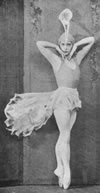
BL. W. B. Yeats
37. A Full Moon in March. London: Macmillan, 1935.
 |
|||
| Ninette de Valois, to whom The
King of the Great Clock Tower was dedicated. |
Reprints Ribh at the Tomb of Baile and Aillinn (36c).
a. Preface. After a friend he had trusted in the past had ‘denounced . . . in violent language’ the prose version of The King of the Great Clock Tower (36a) Yeats concluded that prose dialogue was as unpopular among his ‘studious friends’ as verse among ‘actors and playgoers’, and so he has rewritten The King of the Great Clock Tower in verse, though recommends the earlier version to anyone ‘inclined to play it’; further, to reduce the ‘fable’ to its ‘essentials’ and to give it ‘greater intensity’, he has ‘started afresh’ with a new version in verse, which eliminates the King, and presents it here as A Full Moon in March.
b. A Full Moon in March. The King of the great Clock Tower (36a and 37c) reduced to its ‘essentials’. Taylor (226) calls this work ‘the most highly developed of the dance plays derived from the Japanese nôh’. First appeared in Poetry in March 1935. See also 98, 120, 207, and 214.
c. The King of the Great Clock Tower. A verse revision of the earlier play of the same title (36a), for Yeats’s ‘studious friends’ (see a above). Wilson (98) finds the work ‘perhaps the closest Yeats ever came in a dance-play to the realisation of the formal ideal he took over from the Japanese’. Dedicated to Ninette de Valois, founder of the Abbey School of Ballet, associated with the Abbey Theatre, and dancer in several productions of Yeats’s plays, ‘asking pardon for covering her expressive face with a mask’. See also 207.

